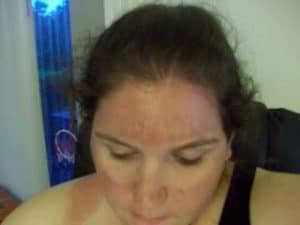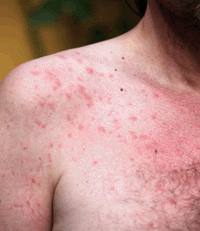What is a sun poisoning rash? Get more insights on meaning, pictures, treatment and prevention of sun poisoning rash. Also, find out how tanning beds can cause rash and what to do.
* As an Amazon Associate I earn from qualifying purchases.
The formation of a rash characterized by small bumps is one of the major immediate symptoms of sun poisoning. The rush can last for a few days or may become severe which can easily cause skin cancer and other blemishes such as freckles, scars, wrinkles and eye diseases. Sunburn causes skin dehydration and when touched or rubbed a few days after, swelling blisters and peeling can happen.
Sun poisoning associates temporary symptoms though when the skin is damaged it can become permanent. To realize severe damage, you will start feeling pain and irritation after the sun poisoning rash has disappeared.

Sun Poisoning Rash Pictures – What it Looks Like?
Red, itch and painful skin can be a sign of sun poisoning rash. This is a way of the body reacting to the heating effect and harmful radiation from the sun. Unprotected sun exposure can cause the formation of the rush within 30 minutes of exposure. Other risk factors for sunburn rush include the use of some types of medicines and skin products that makes the skin vulnerable to sun poisoning.
Sun poisoning rash symptoms include; formation of small red and itchy bumps on the face or skin, blisters of different sizes, headache, nausea, fever, chills and dizziness. Depending on the heating intensity and exposed duration, symptoms can be mild or chronic. Mild symptoms may subside within a couple of days following a first aid or application of sun poisoning home remedy.
Severe and chronic sun poisoning rush can be persistent as well associating other skin blemishes such as moles, freckles, and uneven skin tone. Various treatment for sun poisoning methods can be used in managing the situation. Sun poisoning prevention is the most recommended way of fixing and avoiding further problems.
What to Do for Sun Poisoning Rash?

Sun poisoning rash can be realized a few hours after sun exposure. When you get at home and notice some signs such as; itchiness, redness, blisters, wheezing, dizziness and loss of consciousness, here are quick home care steps you need to take in preventing more damage to the skin:
- Take a cool shower or bath or place clean wet, cool wash rags on the burn.
- Avoid using products that can cause skin allergic reactions and burns such as benzocaine or lidocaine.
- Cover blisters with dry bandages to avoid bacterial infections.
- Drink a glass of cold water that is not ice cold to stay hydrated.
- You can apply a moisturizer to the skin to relieve the tension. Avoid using oil skin moisturizers such as petroleum jelly (Vaseline) among others since they can block the pores hence retaining the heat and sweat.
- Go for over the counter anti-inflammatory and pain killer medicines such as ibuprofen or acetaminophen.
- You can use cortisone creams to reduce and prevent inflammation.
- Do not wear tight nylon material clothing but instead go for loose cotton.
- Stay out of the sun to avoid further sun poisoning.
- Apply Aloe Vera Gel lotion or cream on the affected area of the skin. You can use a direct natural extract of this ingredient or you can obtain the products from the drugstores.
- Compress the face with a mixture of milk and water in equal amounts.
- Use SPF a sun protection factor of 30 or above which you should apply regularly when outdoors.
- Highest Quality - to ensure freshness our Aloe is proudly grown here in Southern Texas. NSF Organic & IASC Certified.
- Harvested For Us - from real freshly cut aloe leaves, not powder - making it one of the purest and strongest on the market. For that reason please test on less sensitive areas first to make sure no reactions occur (before you apply to your face)
- The Difference in Skin Treated with Seven Minerals Aloe Gel is Striking. Thanks to 100% natural thickener Agar (instead of Xanthan or Carbomer), it absorbs rapidly with no sticky residue - leaving your skin smooth and silky
- Discover Nature's Miracle Plant - Soothe your sunburn, treat your cuts, clear up your rashes, take the sting out of bites, calm your shaving burn and more!
- Repair and Soothe your Skin Daily - Our Pure Aloe Vera Gel is a clear, slightly thinner gel - an excellent daily treatment for face, skin & hair. Regular use soothes the skin leaving it soft and supple with a healthy glow
* As an Amazon Associate I earn from qualifying purchases.
- Made with 100% pure petrolatum.
- Purity is guaranteed with our triple-purified formula.
- Free of fragrance and hypoallergenic.
* As an Amazon Associate I earn from qualifying purchases.
- 6.7-ounce bottle of Neutrogena Beach Defense Water Resistant Sunscreen Lotion with SPF 70 that helps prevent sunburn and decrease the risk of skin cancer and early skin aging caused by the sun when used as directed
- With Helioplex technology, this sunscreen provides superior protection against skin-aging UVA and skin-burning UVB rays. This sunscreen lotion helps prevent sunburn and when used as directed, may help decrease the risk of skin cancer caused by the sun
- Fast-absorbing, broad spectrum SPF 70 sunscreen lotion is designed for your active family's outdoors activities. The body sunscreen features a lightweight, oil-free, PABA-free and oxybenzone-free formula
- Beach-strength sunscreen lotion formula with SPF 70 can stand up to outdoor activities and is water resistant for up to 80 minutes. Apply lotion 15 minutes before sun exposure and reapply after 80 minutes of swimming or sweating
- Superior sun protection from the #1 dermatologist recommended suncare brand in a lightweight sunscreen lotion with a new formula that contains no oxybenzone, absorbs quickly and is easy to apply
* As an Amazon Associate I earn from qualifying purchases.
Sun poisoning rash can become severe and chronic. You need to seek emergency medical attention if the symptoms become more serious. This is when there is severe pain, severe blistering, headache, confusion, vomiting, fainting and dizziness. These could also be a sign of a serious underlying medical condition that requires emergency medical attention.
Sun Poisoning Rash Treatment – How to Treat?

Treatment for sun poisoning rash will depend on the type of poisoning and the intensity of burning. First aid is normally the initial treatment and it involves over the counter pain killers such as ibuprofen or naproxen. Sunburn lotions and creams can also be used in the prevention of the situation. Silver Sulfadiazine is an example of the best effective topical cream for the treatment and prevention of sunburn and must be used under the doctor’s recommendation.
- Superior Colloidal Silver Gel with Organic Aloe Vera Known for Skin Health and Wellness Properties.
- Fast-Absorbing Quickly dissipates into Skin. PH Balanced for Use on Both Oily & Dry skin.
- Soothing Formula for Daily use by Adults & Children. NON-Greasy Lightweight Gel Hydrator.*
- This Easy Flow Gel is made with Organic Aloe Vera. "Please" Be Sure you are not Allergic to Aloe Vera before using.*
- This gel is amazing and its uses are endless including but not limited to a shave gel, hair gel, makeup base, as well as a topical body gel.
* As an Amazon Associate I earn from qualifying purchases.
When the sun poisoning on the face is mild and not life-threatening, more fluids may be recommended by the doctor. Taking aspirin and no steroidal anti-inflammatory drugs may be used to fix the swelling and blisters. The patient may also be suggested for cool compresses such as Burow’s solution soaks and application of effective moisturizing creams and lotions to the affected area.
Oral steroid therapy can be used for severe cases. This mostly involves the prescription of cortisone medications for some time. This can also involve strong pain reliever medications depending on the doctor’s observation and recommendation. Silver sulfadiazine is an effective treatment though it may not be used on the face due to side effects.
How to Prevent Sun Poisoning Rash?
- The sun is normally too hot during peak hours. Avoid getting outdoors from 10 am to 4 pm.
- Wear wide-brimmed hats, sunglasses with UV protection, long-sleeved shirts, and pants.
- Avoid medications and drugs that make your skin vulnerable to the sun poisoning
- Avoid abuse of substances such as excessive use of mind-altering drugs which will impair your judgment.
- Be cautious while going for short and sequential sun exposure since it can cause tanning and skin cancer in the long run.
- Avoid tanning beds since they are associated with serious cell conditions such as basal cell carcinoma and squamous cell carcinoma.
- Young adults and children are at high risk of sun poisoning compared to aged people.
- Use sunscreen and sun protection while outdoors.
Sun Poisoning Rash From Tanning Bed

A tanning bed is highly associated with sun poisonings rash and serious cell conditions like basal cell carcinoma and squamous cell carcinoma. Blisters on the face can also form due to sun poisoning experienced on tanning beds. These beds can also associate a swollen face and peeling of the skin. Quick measures need to be taken since symptoms can become chronic and the rush can erupt and cause bacterial infections such as cancer. Use of appropriate sunscreen and sun protection is the best way to prevent sun poisoning rash and blisters.
While going for sunblock pay more attention to the sun protection factor (SPF) and don’t mind about the PABA since some sensitive skin types are allergic to PABA. This element should not be used in children below 1-year-old due to its ability to cause irritation. This chemical element is therefore not common in many sunscreens due to such side effects.
The product with high SPF offers more protection against UV and UVB rays. This is simply a ratio of the time such a product takes to produce a skin reaction on both protected and unprotected skin. In layman’s, a product with SPF 30 would allow an individual to be exposed 30 times longer than one with no sunscreen when other factors are held constant.
The American Academy of Dermatology recommends people to use a broad spectrum waterproof sunscreen with an SPF of at least 30. Apply enough and on regular basis. While on sun application after every 2 hours is recommended by the American Academy of Dermatology.
You are also advised to use a lip balm with SPF 30 and above to prevent your lips from sun poisoning effects. Beware that not all sunscreen is water-resistant, swimming and sweating can degrade the effectiveness of such nonwaterproof sunscreens and therefore replying is the best way to ensure your protection against harmful radiations from the sun.




